 W
WPeter Abelard was a medieval French scholastic philosopher, theologian, composer, poet and preeminent logician. His love for, and affair with, Héloïse d'Argenteuil has become legendary. The Chambers Biographical Dictionary describes him as "the keenest thinker and boldest theologian of the 12th century".
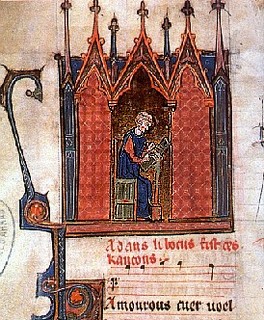 W
WAdam de la Halle, (1240–1287) also known as Adam le Bossu (1240–1287), was a French trouvère, poet and musician. Adam's literary and musical works include chansons and jeux-partis in the style of the trouvères; polyphonic rondel and motets in the style of early liturgical polyphony; and a musical play, Jeu de Robin et Marion, which is considered the earliest surviving secular French play with music. He was a member of the Confrérie des jongleurs et bourgeois d'Arras.
 W
WGuilhem Ademar was a troubadour from the Gévaudan in France. He travelled between the courts of Albi, Toulouse, Narbonne, and Spain. He achieved fame enough during his life to be satirised by the nobleman and monk, Monge de Montaudon. Guilhem entered holy orders towards the end of his life. Sixteen poems—fourteen cansos, a sirventes, and a partimen with Eble d'Ussel—form his surviving corpus. His cansos are his most famous pieces. Usually humorous, several mock the poetry of Ademar's more illustrious contemporary Arnaut Daniel. One canso survives with a tune.
 W
WAlbertet de Sestaro, sometimes called Albertet de Terascon, was a Provençal jongleur and troubadour from the Gapençais. Of his total oeuvre, twenty three poems survive. "Albertet" or "Albertetz" is the Occitan diminutive of Albert. Unqualified it usually refers to Albertet de Sestaro, but there was an Albertet Cailla.
 W
WDer wilde Alexander, also known as Meister Alexander, was a medieval Minnesänger who was active from the mid-1200s until after 1288. His works are considered to be part of the Sangspruchdichtung.
 W
WAlfonso X was the king of Castile, León and Galicia from 30 May 1252 until his death in 1284. During the election of 1257, a dissident faction chose him to be king of Germany on 1 April. He renounced his claim to Germany in 1275, and in creating an alliance with the Kingdom of England in 1254, his claim on the Duchy of Gascony as well.
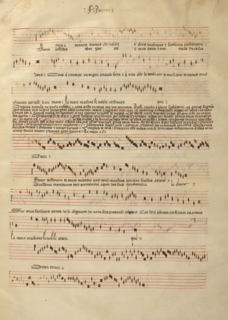 W
WF. Andrieu was a French composer in the ars nova style of late medieval music. Nothing is known about him except that he wrote a double ballade déploration, Armes, amours/O flour des flours, on the death of Guillaume de Machaut in 1377. The work has been widely praised and analyzed; it is notable for being one of two extant four-part double ballades of medieval music, the only know contemporary musical setting of Eustache Deschamps and the earliest representative of the longstanding medieval and Renaissance lamentation tradition for a fellow composer. He may be the same person as Magister Franciscus, although the scholarly consensus on this identification is unclear. With P. des Molins, Jehan Vaillant and Grimace, Andrieu was one of the "post-Machaut" generation whose pieces retain enough ars nova qualities to be separable from composers of ars subtilior.
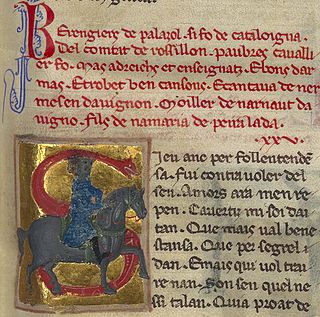 W
WBerenguier de Palazol, Palol, or Palou was a Catalan troubadour from Palol in the County of Roussillon. Of his total output twelve cansos survive, and a relatively high proportion—eight—with melodies.
 W
WBernart de Ventadorn was a prominent troubadour of the classical age of troubadour poetry. Now thought of as "the Master Singer" he developed the cançons into a more formalized style which allowed for sudden turns. He is remembered for his mastery as well as popularisation of the trobar leu style, and for his prolific cançons, which helped define the genre and establish the "classical" form of courtly love poetry, to be imitated and reproduced throughout the remaining century and a half of troubadour activity.
 W
WGautier de Coincy (1177–1236) was a French abbot, trouvère and musical arranger, chiefly known for his devotion to the Virgin Mary.
 W
WArnaut Daniel was an Occitan troubadour of the 12th century, praised by Dante as "the best smith" and called a "grand master of love" by Petrarch. In the 20th century he was lauded by Ezra Pound in The Spirit of Romance (1910) as the greatest poet to have ever lived.
 W
WDenis, called the Farmer King and the Poet King, was King of Portugal. The eldest son of Afonso III of Portugal by his second wife, Beatrice of Castile, and grandson of Alfonso X of Castile, Denis succeeded his father in 1279. His marriage to Elizabeth of Aragon, who was later canonised as a saint of the Roman Catholic Church, was arranged in 1281 when she was 10 years old.
 W
WElias Cairel was a troubadour of international fame. Born in Sarlat in the Périgord, he first travelled with the Fourth Crusade and settled down in the Kingdom of Thessalonica at the court of Boniface of Montferrat (1204–1208/10) before moving back to western Europe, where he sojourned at the court of Alfonso IX of León (1210–11) and in Lombardy (1219–1222/24). He wrote fourteen surviving lyrics: ten cansos, one tenso, one descort, one sirventes, and one Crusade song. He was partial to refrain rhyming and coblas capfinidas.
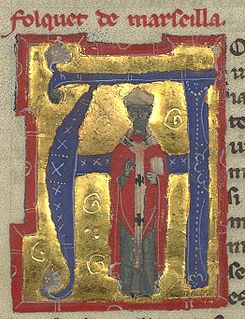 W
WFolquet de Marselha, alternatively Folquet de Marseille, Foulques de Toulouse, Fulk of Toulouse came from a Genoese merchant family who lived in Marseille. He is known as a trobadour, and then as a fiercely anti-Cathar bishop of Toulouse.
 W
WFranco of Cologne was a German music theorist and possibly a composer. He was one of the most influential theorists of the late Medieval era, and was the first to propose an idea which was to transform musical notation permanently: that the duration of any note should be determined by its appearance on the page, and not from context alone. The result was Franconian notation.
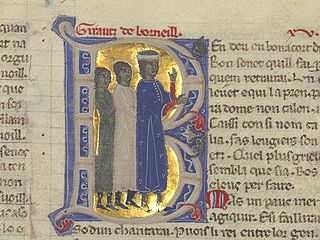 W
WGiraut de Bornelh, whose first name is also spelled Guiraut and whose toponym as de Borneil or de Borneyll, was a troubadour connected to the castle of the viscount of Limoges. He is credited with the formalisation, if not the invention, of the "light" style, or trobar leu.
 W
WGodric of Finchale was an English hermit, merchant and popular medieval saint, although he was never formally canonised. He was born in Walpole in Norfolk and died in Finchale in County Durham.
 W
WGrimace was a French poet and composer of the ars nova style in late medieval music. Virtually nothing is known about Grimace's life other than speculative information based on the circumstances and content of his five surviving compositions of formes fixes; three ballades, a virelai and rondeau. Three of his works were included in the Chantilly Codex, which is an important source of ars subtilior music. However, along with P. des Molins, Jehan Vaillant and F. Andrieu, Grimace was one of the post-Guillaume de Machaut generation whose music shows few distinctly ars subtilior features, leading scholars to recognize Grimace's work as closer to the ars nova style of Machaut. His most often performed work is the virelai and proto-battaglia: A l’arme A l’arme.
 W
WGuillem or Guilhem Magret was a troubadour and jongleur from the Viennois. He left behind eight poems, of which survive a sirventes and a canso with melodies.
 W
WGuiraut Riquier de Narbona is among the last of the Occitan troubadours. He is well known because of his great care in writing out his works and keeping them together—the New Grove Encyclopedia considers him an "anthologist" of his own works.
 W
WBlessed Hermann of Reichenau, also known by other names, was an 11th-century Benedictine monk and scholar. He composed works on history, music theory, mathematics, and astronomy, as well as many hymns. He has traditionally been credited with the composition of "Salve Regina", "Veni Sancte Spiritus", and "Alma Redemptoris Mater", although these attributions are sometimes questioned. His cultus and beatification were confirmed by the Roman Catholic Church in 1863.
 W
WJaufre Rudel was the Prince of Blaye and a troubadour of the early–mid 12th century, who probably died during the Second Crusade, in or after 1147. He is noted for developing the theme of "love from afar" in his songs.
 W
WJan z Jenštejna, German: Johann II. von Jenstein, Johannes VI. von Jenstein. Johann von Jenzenstein, Johann von Genzenstein was the Archbishop of Prague from 1379 to 1396. He studied in Bologna, Padova, Montpellier and Paris. He was also a poet, writer and composer.
 W
WJohn Koukouzelis or Jan Kukuzeli was a Byzantine medieval Orthodox Christian composer, singer and reformer of Eastern Orthodox music. He was recognized as a saint by the Eastern Orthodox Church after his death. His music is held in high esteem by Albanians, Bulgarians, Greeks, Macedonians, Romanians and Serbs.
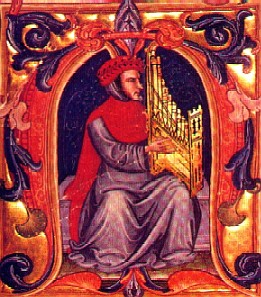 W
WFrancesco degli Organi, Francesco il Cieco, or Francesco da Firenze, called by later generations Francesco Landini or Landino was an Italian composer, organist, singer, poet and instrument maker. He was one of the most famous and revered composers of the second half of the 14th century, and by far the most famous composer in Italy.
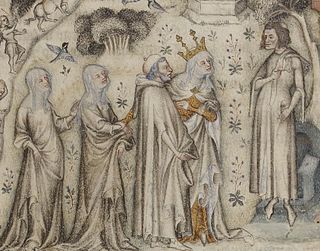 W
WGuillaume de Machaut was a French poet and composer of late Medieval music who was the central figure of the ars nova style. Immensely influential, Machaut is regarded as the most important composer and poet of the 14th century and is the first significant composer whose name is known. Daniel Leech-Wilkinson called him "the last great poet who was also a composer", and well into the 15th century Machaut's poetry was greatly admired and imitated by other poets, including Geoffrey Chaucer.
 W
WMarcabru is one of the earliest troubadours whose poems are known. There is no certain information about him; the two vidas attached to his poems tell different stories, and both are evidently built on hints in the poems; not on independent information.
 W
WMartin Codax or Martim Codax was a Galician medieval joglar - possibly from Vigo, Galicia in present-day Spain. He may have been active during the middle of the thirteenth century, judging from scriptological analysis. He is one of only two out of a total of 88 authors of cantigas d'amigo who used only the archaic strophic form aaB. He employed an archaic rhyme-system whereby i~o / a~o were used in alternating strophes. In addition Martin Codax consistently utilised a strict parallelistic technique known as leixa-pren. There is no documentary biographical information concerning the poet, dating the work at present remains based on theoretical analysis of the text.
 W
WThe Monk of Salzburg was a German composer of the late 14th century. He worked at the court of the Salzburg archbishop Pilgrim von Puchheim (1365–96); more than 100 Liederhandschriften (manuscripts) in Early New High German are attributed to him.
 W
WPeire de Maensac was an Auvergnat knight and troubadour. He was from Maensac in the lands of Dalfi d'Alvernha. He came from the petty nobility. His brother Austor or Austors was also a troubadour, but none of his works survives. According to Peire's vida the brothers agreed that one of them would "have the castle" and the other would be the "inventor". Peire became the troubadour.
 W
WPeire Raimon de Tolosa was a troubadour from the merchant class of Toulouse. He is variously referred to as lo Viellz and lo Gros, though these are thought by some to refer to two different persons. On the other hand, lo Viellz could refer to his being of an early generation of troubadours. Eighteen of Peire Ramon's poems survive, one canso with a melody.
 W
WPerotinus Magnus, was a composer from around the late 12th century, associated with the Notre Dame school of polyphony in Paris and the ars antiqua musical style. The title Magister Perotinus means that he was licensed to teach. The only information on his life with any degree of certainty comes from an anonymous English student at Notre Dame known as Anonymous IV. It is assumed that he was French and named Pérotin, a diminutive of Peter, but attempts to match him with persons in other documents remain speculative.
 W
WRigaut de Berbezilh was a troubadour of the petty nobility of Saintonge. He was a great influence on the Sicilian School and is quoted in the Roman de la Rose. About fifteen of his poems survive, including one planh and nine or ten cansos. His name is sometimes given as Richart or Richartz.
 W
WMeister Rumelant or Rumslant was a Middle High German lyric poet. His origin is uncertain, although in his poems he referred to himself as a "Saxon". His name suggests the life of a touring minstrel.
 W
WPhilippe de Vitry was a French composer, music theorist and poet. He was an accomplished, innovative, and influential composer, and may also have been the author of the Ars Nova treatise. He was widely acknowledged as the greatest musician of his day, with Petrarch writing a glowing tribute, calling him: "... the keenest and most ardent seeker of truth, so great a philosopher of our age."
 W
WAntonio "Zacara" da Teramo was an Italian composer, singer, and papal secretary of the late Trecento and early 15th century. He was one of the most active Italian composers around 1400, and his style bridged the periods of the Trecento, ars subtilior, and beginnings of the musical Renaissance.